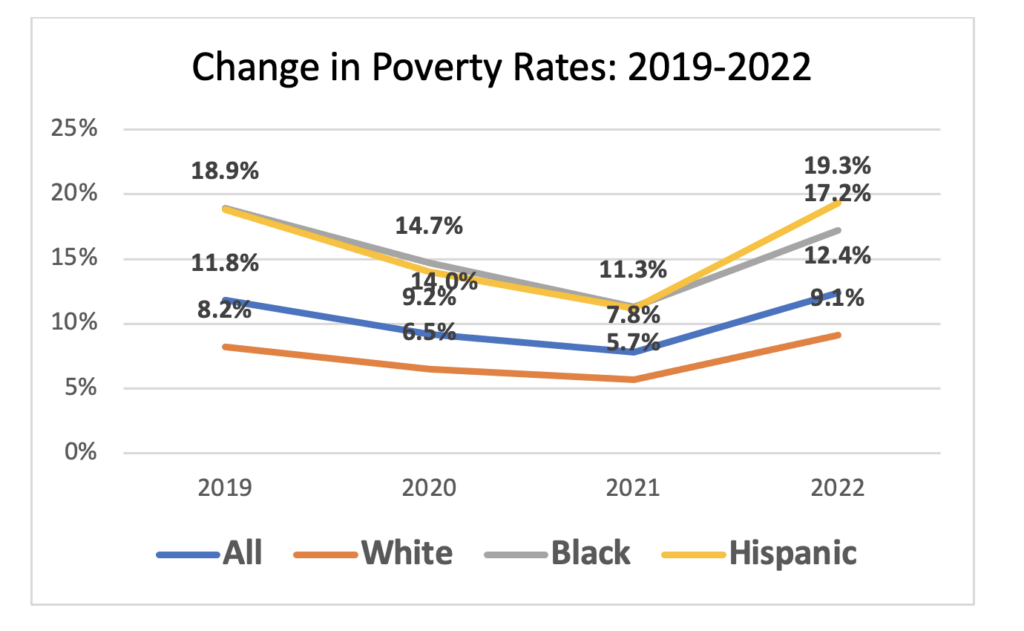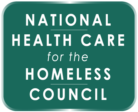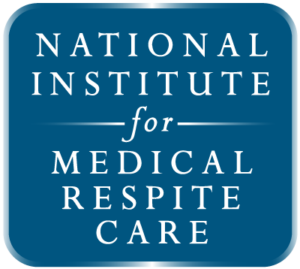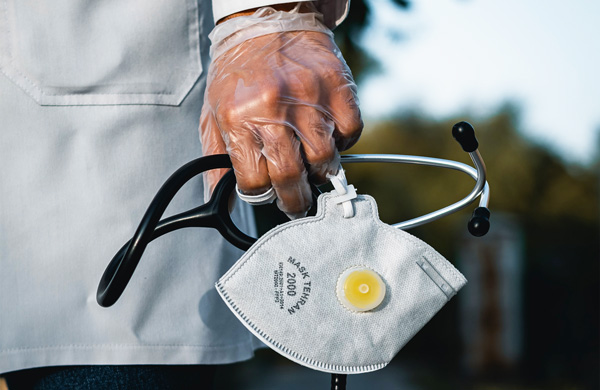by Barbara DiPietro, Senior Director of Policy
The U.S. Census Bureau released its annual report on income, poverty, and health insurance this month, reflecting 2022 data. The chart below shows poverty rates from 2019 to 2022 across racial groups—and you probably notice three things right away:
- Black and Brown folks experience poverty at about twice the rate of White folks
- Something happened in 2020 and 2021 to significantly reduce poverty for all groups
- Something happened in 2022 that erased all that progress—and made it worse


Note: This data uses the supplemental poverty measure because it includes more information relevant to discussing poverty.
So what happened?
The short answer: At the onset of the COVID-19 pandemic, Congress quickly enacted a significant safety net that helped millions of people escape poverty. Then, Congress pulled it all back.
The long(er) answer: Congress passed at least three major aid packages in 2020 and 2021 that bolstered aid across many areas, to include cash payments; significantly expanded unemployment benefits; expansions in food, utility assistance, and housing aid; expanded tax credits; paid sick and family leave; and continuous eligibility for Medicaid (which offsets expenditures for health care).
More specifically:
- Three rounds of Economic impact payments (aka “stimulus checks”): In March 2020, these provided $1,200 per adult + $500 for each child for those earning below $75,000. In December 2020, another round of payments went out up to $600 per adult and child. In March 2021, a third round went out for $1,400 for single adults, $2,800 for married couples, plus another $1,400 for each dependent.
- Federal Pandemic Unemployment Compensation program: Between April and July 2020, weekly supplements to expanded state unemployment aid added $600 per week to benefits (later reduced to $300 per week between December 2020 and September 2021)
- Aid to food/nutrition programs: Additional funding for the Women, Infants, and Children (WIC) program as well as the Supplemental Nutrition Assistance Program (SNAP, or food stamps)
- Aid to housing/homelessness programs: Additional funding for tenant- and project-based rental assistance, public housing, Housing for Persons with HIV/AIDS (HOPWA), and others. Also expanded energy assistance through the Low Income Home Energy Assistance Program (LIHEAP)
- Moratoriums on evictions: Prohibited evictions of renters in homes with federally backed mortgages and most federally subsidized apartments
Three NHCHC fact sheets from the pandemic provide more detail about each round of funding:
- Consolidated fact sheet for the Coronavirus Preparedness and Response Act, the Families First Coronavirus Response Act, and the Coronavirus Aid, Relief, and Economic Security (CARES) Act, all from March 2020
- Consolidated Appropriations Act, December 2020
- American Rescue Plan, March 2021
The combined impact of this aid lifted millions out of poverty, reducing poverty for all racial groups through 2020 and 2021. Unfortunately, Congress chose not to continue this aid—allowing one Senator to hold up many program extensions. Also recall that the original Build Back Better legislation (November 2021) was to include historic health and housing investments—which were never included in the final Inflation Reduction Act of 2022. So households are largely back to the pre-pandemic safety net, which is why poverty shot back up (and over) where it was before. Decreases in poverty were due to conscious public policy choices—in exactly the same way that current increases in poverty are from undoing those exact same policy choices. It’s not an accident.
So what can you do?
- Most directly, call your Congressional representative and tell him/her why you think chronically underfunding—and flat-out DEfunding—critical programs is wrong! Call your Senators too! There’s a specific group of very conservative legislators (ironically named The Freedom Caucus) that is opposed to just about all funding, and is seeking massive reductions in federal spending. These are the folks who are focused on shutting down the government over their extreme demands (see the other section in this month’s Mobilizer).
- Educate your elected officials! Invite them to site visits to see your program and meet those you serve. Organize roundtable discussions with them and your clients and staff. Maybe you won’t change them completely, but maybe they’ll soften their approach (harm reduction!).
- Vote! Make sure you are registered, and take steps to register others as well. Hold voter registration and voter turnout events at your program (yes, this is legal).
- Get other people elected! If you don’t like who represents you in Congress, work to change that. Get behind those who reflect your values and are proposing solutions that align with what you want to see happen.
- Focus on REDUCING racial disparities! Advance policies that disproportionately benefit BIPOC groups, such as higher wages, more child care, and more equitable educational and employment opportunities. Structural racism in our policies is a conscious choice too (just sayin’).
- Participate in the revolution! Something BIG has to change in order for us to prevent and end homelessness. I can’t say I know what “the revolution” is specifically—only that we desperately need one.
In Solidarity,
Barbara
P.S. The good news from the Census report is that health insurance was at an all-time high—with the 2022 rate of uninsured at 7.9%. Of course, with the Medicaid continuous eligibility component now expired and millions being kicked off Medicaid (see Mobilizer section on this issue!)—coupled with increasing health insurance expenses—look for a spike in uninsured in NEXT year’s Census data. Increases in uninsured will not be an accident—they are directly caused by conscious public policy choices.



